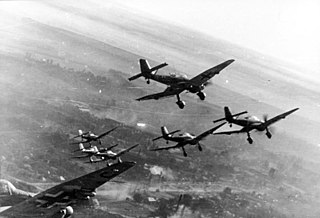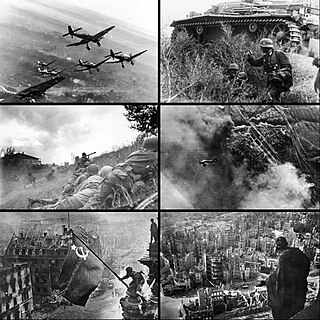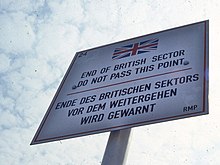
East Berlin was the partially recognised capital of East Germany (GDR) from 1949 to 1990. From 1945, it was the Soviet occupation sector of Berlin. The American, British, and French sectors were known as West Berlin. From 13 August 1961 until 9 November 1989, East Berlin was separated from West Berlin by the Berlin Wall. The Western Allied powers did not recognize East Berlin as the GDR's capital, nor the GDR's authority to govern East Berlin. For most of its administrative existence, East Berlin was officially known as Berlin, capital of the GDR by the GDR government. On 3 October 1990, the day Germany was officially reunified, East and West Berlin formally reunited as the city of Berlin.

World War II or the Second World War was a global conflict between two coalitions: the Allies and the Axis powers. Nearly all of the world's countries—including all the great powers—participated, with many investing all available economic, industrial, and scientific capabilities in pursuit of total war, blurring the distinction between military and civilian resources. Tanks and aircraft played major roles, with the latter enabling the strategic bombing of population centres and delivery of the only two nuclear weapons ever used in war. World War II was the deadliest conflict in history, resulting in 70 to 85 million fatalities, more than half of which were civilians. Millions died in genocides, including the Holocaust of European Jews, and by massacres, starvation, and disease. Following the Allied powers' victory, Germany, Austria, Japan, and Korea were occupied, and war crimes tribunals were conducted against German and Japanese leaders.

The European theatre of World War II was one of the two main theatres of combat during World War II. It saw heavy fighting across Europe for almost six years, starting with Germany's invasion of Poland on 1 September 1939 and ending with the Western Allies conquering most of Western Europe, the Soviet Union conquering most of Eastern Europe including the German capital Berlin, and Germany's unconditional surrender on 8 May 1945 although fighting continued elsewhere in Europe until 25 May. On 5 June 1945, the Berlin Declaration proclaiming the unconditional surrender of Germany to the four victorious powers was signed. The Allied powers fought the Axis powers on two major fronts, but there were other fronts varying in scale from the Italian campaign, to the Polish Campaign, as well as in a strategic bombing offensive and in the adjoining Mediterranean and Middle East theatre.

The final battles of the European theatre of World War II continued after the definitive surrender of Nazi Germany to the Allies, signed by Field marshal Wilhelm Keitel on 8 May 1945 in Karlshorst, Berlin. After German leader Adolf Hitler's suicide and handing over of power to grand admiral Karl Dönitz on the last day of April 1945, Soviet troops conquered Berlin and accepted surrender of the Dönitz-led government. The last battles were fought on the Eastern Front which ended in the total surrender of all of Nazi Germany’s remaining armed forces such as in the Courland Pocket in western Latvia from Army Group Courland in the Baltics surrendering on 10 May 1945 and in Czechoslovakia during the Prague offensive on 11 May 1945.

The Soviet occupation zone in Germany was an area of Germany that was occupied by the Soviet Union as a communist area, established as a result of the Potsdam Agreement on 1 August 1945. On 7 October 1949 the German Democratic Republic (GDR), commonly referred to in English as East Germany, was established in the Soviet occupation zone.

Operation Unthinkable was the name given to two related possible future war plans developed by the British Chiefs of Staff Committee against the USSR during 1945. The plans were never implemented. The creation of the plans was ordered by British Prime Minister Winston Churchill in May 1945 and developed by the British Armed Forces' Joint Planning Staff in May 1945 at the end of World War II in Europe.

The entirety of Germany was occupied and administered by the Allies of World War II, from the Berlin Declaration on 5 June 1945 to the establishment of West Germany on 23 May 1949. Unlike occupied Japan, Nazi Germany was stripped of its sovereignty and former state: after Germany formally surrendered on 8 May 1945, the four countries representing the Allies asserted joint authority and sovereignty through the Allied Control Council (ACC).

U.S. Army Berlin (USAB) was a command of the United States Army created in December 1961, at the height of the Berlin Wall crisis. USAB was a combined command with the Headquarters, U.S. Command Berlin (USCOB). This combined organization was sometimes called the "Berlin Command". USCOB/USAB was a separate command from the U.S. Army Europe (USAREUR) which had previously been in command of American troops in West Berlin.

The Berlin Brigade was a US Army brigade-sized garrison based in West Berlin during the Cold War. After the end of World War II, under the conditions of the Yalta and Potsdam agreements, the Allied forces occupied West Berlin. This occupation lasted throughout the Cold War. The French Army also had units in Berlin, called French Forces in Berlin and the British Army's unit in Berlin was the Berlin Infantry Brigade.

The 78th Infantry Division, also known as the Battleaxe Division, was an infantry division of the British Army, raised during the Second World War that fought, with great distinction, in Tunisia, Sicily and Italy from late 1942–1945.

Dahlem is a locality of the Steglitz-Zehlendorf borough in southwestern Berlin. Until Berlin's 2001 administrative reform it was a part of the former borough of Zehlendorf. It is located between the mansion settlements of Grunewald and Lichterfelde West.

The Free Belgian forces were soldiers from Belgium and its colonies who fought as part of the Allied armies during World War II, after the official Belgian surrender to Nazi Germany. It is distinct from the Belgian Resistance which existed in German-occupied Belgium.

The McNair Barracks was a US Army installation in Lichterfelde, a locality in southwest Berlin, Germany. The barracks were named after Lieutenant General Lesley J. McNair, an American Army officer who served in World War I and World War II and was killed in an infamous friendly fire incident on 25 July 1944 in the Battle of Normandy. The barracks housed the Infantry and Artillery units of the U.S. Army Berlin Brigade.

In Operation Doomsday, the British 1st Airborne Division acted as a police and military force during the Allied occupation of Norway in May 1945, immediately after the victory in Europe during the Second World War. The division maintained law and order until the arrival of the remainder of Force 134, the occupation force. During its time in Norway, the division was tasked with supervising the surrender of the German forces in Norway, as well as preventing the sabotage of vital military and civilian facilities.

The Allied Control Council (ACC) or Allied Control Authority, and also referred to as the Four Powers, was the governing body of the Allied occupation zones in Germany (1945–1949/1991) and Austria (1945–1955) after the end of World War II in Europe. After the defeat of the Nazis, Germany and Austria were occupied as two different areas, both by the same four Allies. Both were later divided into four zones by the 1 August 1945 Potsdam Agreement. Its members were the Soviet Union, the United Kingdom, the United States, and France. The organisation was based in Schöneberg, Berlin.

The French Forces in Berlin were the units of the French Armed Forces stationed since 1945 until the end of the Cold War-era in West Berlin, according to the agreements of the Yalta Conference and Potsdam Conference. The troops were the French counterparts to the United States' Berlin Brigade and the United Kingdom's Berlin Infantry Brigade in the city.

The Berlin Infantry Brigade was a British Army brigade-sized garrison based in West Berlin during the Cold War. After the end of World War II, under the conditions of the Yalta and Potsdam agreements, the Allied forces occupied West Berlin. This occupation lasted throughout the Cold War. The French Army also had units in Berlin, called the French Forces in Berlin and the US Army's unit in Berlin was the Berlin Brigade.

The Allied Museum is a museum in Berlin. It documents the political history and the military commitments and roles of the Western Allies in Germany – particularly Berlin – between 1945 and 1994 and their contribution to liberty in Berlin during the Cold War era.

The Allied Kommandatura, or often just Kommandatura, also known as the Alliierte Kommandantur in German, was the governing body for the city of Berlin following Germany's defeat in World War II. The victorious allied powers established control of post-war Germany and other territories via shared Military Government councils, including for Berlin. The Kommandatura was often known as the little brother to the Allied Control Council, which had the same function for the whole of Germany, and was subordinate to it. It originally comprised representatives from the United States, the United Kingdom, and the Soviet Union but later included France. The Kommandatura had its home in the Berlin district of Dahlem.

The British occupation zone in Germany was one of the Allied-occupied areas in Germany after World War II. The United Kingdom, along with the Commonwealth, was one of the three major Allied powers that defeated Nazi Germany. By 1945, the Allies had divided the country into four occupation zones: British, Soviet, American and French lasting until 1949, whence the new country of West Germany was established. Out of all the four zones, the British had the largest population and contained within it the heavy industry region, the Ruhr, as well as the naval ports and Germany's coast lines.
























